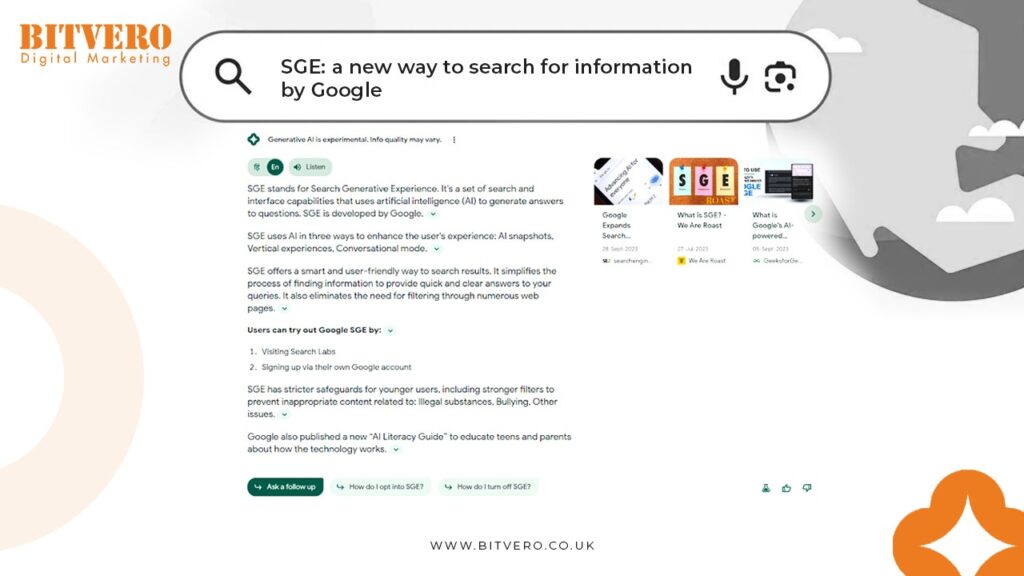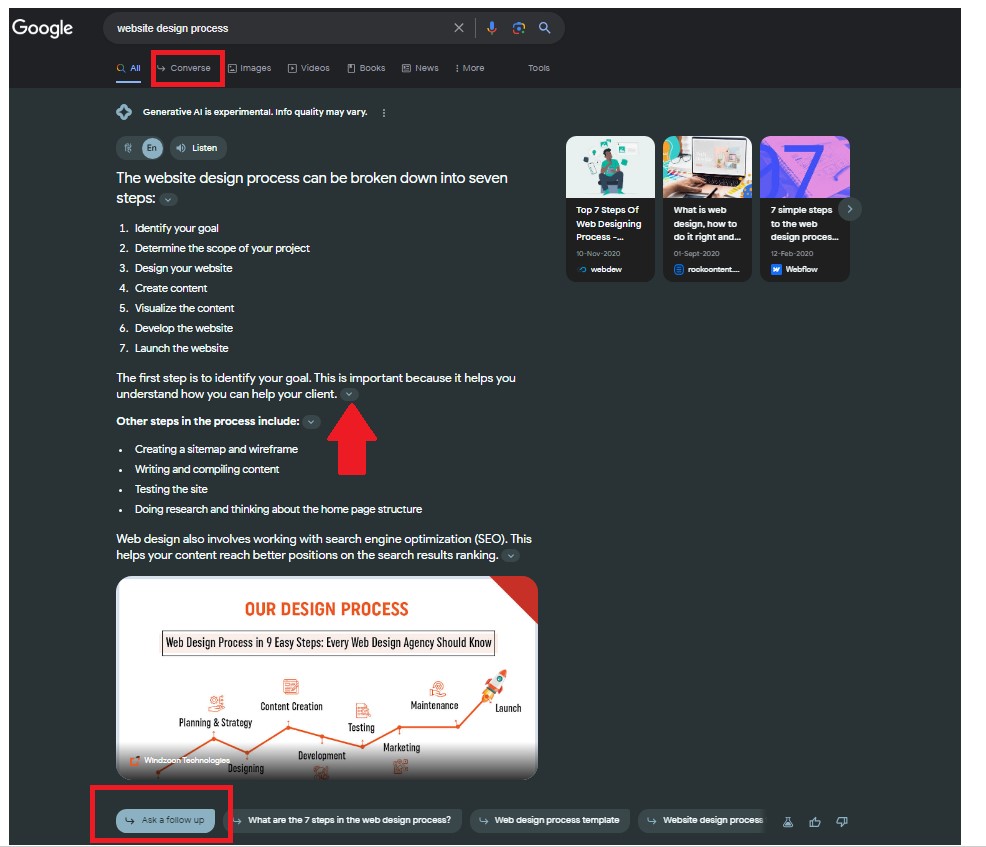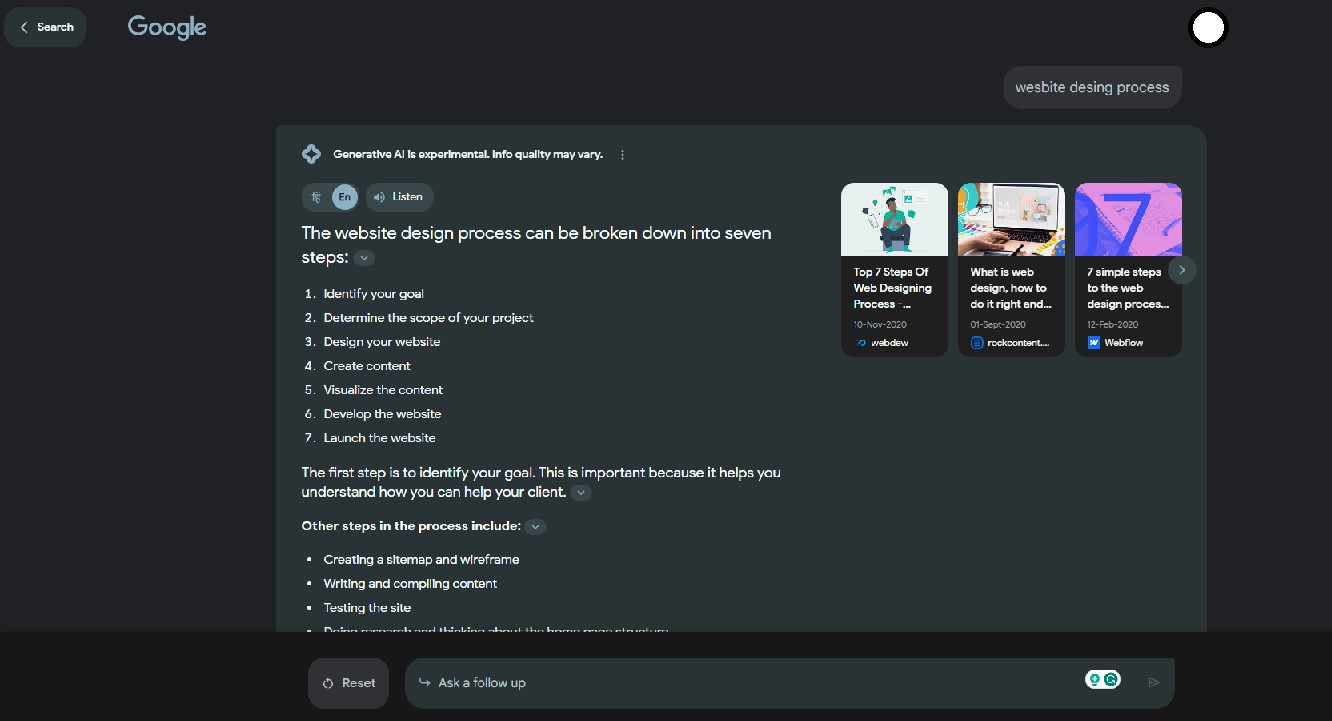SGE: a new way to search for information by Google

As the ChatGPT makes it pretty cool to search for things, other tech giants, including Google, are continuously experimenting with new ways to improve search experience in the field of generative AI.
Previously, Google brought Bard, a ChatGPT rival, to provide its users with an interactive experience.
Now, this time, Google took a step even ahead. Google is rolling out AI-powered solutions to its search results, calling it SGE.
SGE is not specifically a chatbot like Bard or ChatGPT, but it is a whole new feature that Google plans to add to the top of its SERP.
Wait what? On the top of SERP? Wouldn’t that affect the SEO rankings?
When it’s true that it may impact the organic ranking to some extent, Google will not completely remove them from search results. However, they will be shifted down a little.
But the good news is that the newly introduced generative AI will extract the content from the existing websites to generate responses.
That means if your content is good enough, i.e. possesses EEAT qualities, SGE may use it in its response with the reference link to your website.
When SGE’s impact on SEO is important, we will discuss it in a separate article.
For now, we will know what exactly Google SGE is and how it will transform the search experience.
Read also: All about Google & your data privacy.
What is SGE?
SGE stands for Search Generative Experience.
It is a new generative AI model from Google to enhance the search experience. With SGE, users will now get a quick snapshot of the information for any given query.
That means, in place of those traditional blue links we used to get in search results after typing a query in Google’s search box, we will now experience SGE.
SGE will rely on pulling the data from the web and corroborating information to produce the result.
Like other AI models, SGE is also a large language model (LLM), meaning it is trained on massive datasets.
Google leveraged its various LLMs to train SGE, including the advanced versions of MUM & PaLM2.
The speciality of SGE is its multimodality, which comes from the MUM. Multimodality means the model can process text, images, sounds, videos, etc. as input.
How to use SGE?
Before coming to how to use SGE, it is important to know that Google is still experimenting with SGE and, thus, made it available to limited users only.
Initially, some selected users from the US were granted access. However, now Google has expanded its availability to users in India and Japan as well.
In the UK, SGE is yet to be rolled out.
To start with SGE, you must first turn on the SGE response in search results via Search Labs.
The search Lab option appears on the top left side of the screen when you visit www.google.com
Once turned on, you can go to Google’s search box and give any query, say “website design process.”
In response, SGE will generate a quick snapshot of information.

If you want further details, you can just start a follow-up conversation by clicking on the “Ask a follow-up” or “Converse” options.

To verify the information given by the snapshot, you can go to the source website by clicking on the dropdown arrow visible next to the text of each section.
You can also ask to translate the given information into your native language.
Moreover, to have the SGE response read aloud to you, simply click on the “Listen” button at the top of the response.
Note: Get to know if AI content can rank on Google.
SGE is not available for all search queries
Google has not applied SGE response to every type of query we type. For example, if a user is looking for any product or service for which businesses run PPC ads, these ads will be given preference in SERP.
As I searched for website design in London, Google showed me sponsored ads instead of SGE’s response.

Also, Google said that as its ranking systems are designed not to unexpectedly shock or offend people with potentially harmful, hateful, or explicit content, SGE is designed not to show such content in its responses.
Moreover, sensitive topics that Google has categorised as “Your Money or Your Life” (YMYL) will not
come under SGE.
For topics in regard to which no quality information is available on the Internet, SGE refrains from answering them.
Qualities of SGE
Lack of Persona
According to Google, SGE is designed to stay neutral. That means it gives the information on the basis of corroborated information from the web. Because of this, any opinions or emotions present in its data (that’s because of its training in a language that people use to reflect the human experience) will be absent in its responses.
Factuality over fluidity
SGE during a conversation does not go free flowing, acting like a brainstorming partner, so the users are more likely to trust its response, ignoring errors. Rather, its responses will contain facts backed by the relevant resources.
Safe & responsible
SGE is designed in a way that it does not harm users, even indirectly or unintentionally. For example, Google says that when it comes to health-related queries where we do show a response, the disclaimer emphasises that people should not rely on the information for medical advice and should work with medical professionals for individualised care.
Image generation
Google also plans to add an image-generating ability to SGE. For every idea you type as a query, SGE will generate four images to choose from. Google also hinted that it may add an option to get AI-generated images directly in Google Images.
User experience
The main purpose of SGE is to improve the search experience for users. It just transforms the way people engage with information, making it easier and more convenient.
Vertical experience
SGE will also help users in shopping or local searches. Vertical experiences mean SGE will sum up the information of various similar products perpendicularly. In this scenario, you can easily compare and quickly make a decision.
Limitations of SGE
- SGE may sometimes misinterpret information while corroborating.
- Like other AI modes, SGE also has a problem of hallucinating. Google accepts that sometimes it can misrepresent facts or inaccurately identify insights.
- Another challenge with SGE can be biasedness. Not every time, but to some extent, the biases of its training data may impact SGE responses. It’s regardless of the fact that strives to make it neutral.
That’s it
Google it still experimenting SGE with limited features which we have discussed in the article. Once Google is done it will hopefully come with new features to enhance SGE in future. We hope you have got to know about SGE revealed by Google so far.
Those future updates to be introduced, we will try to cover in our articles. So, please keep visiting our blog for more such amazing information.

